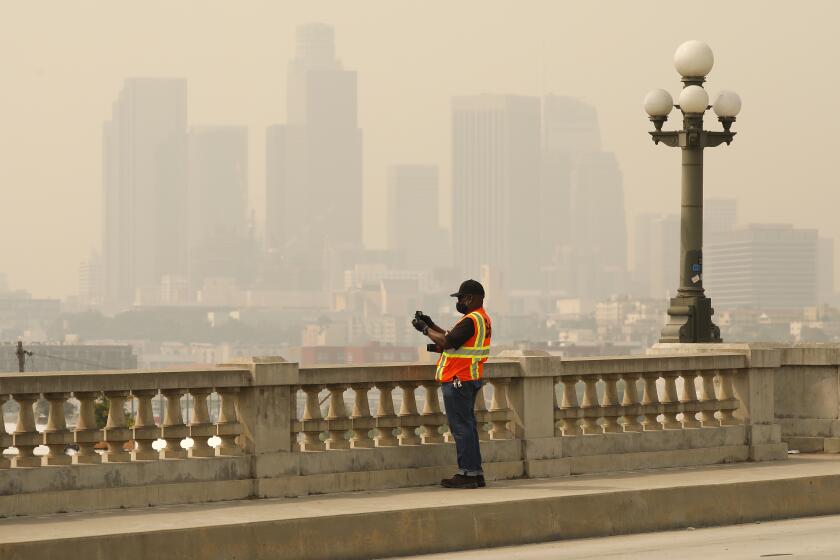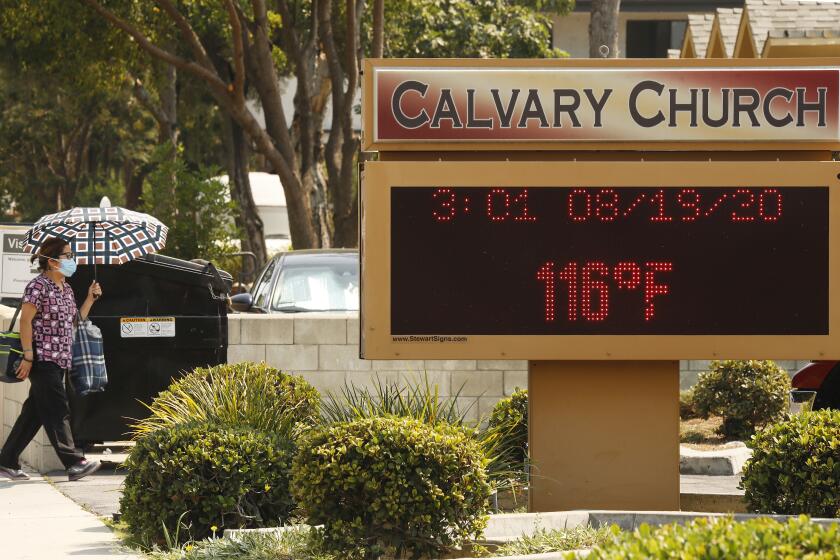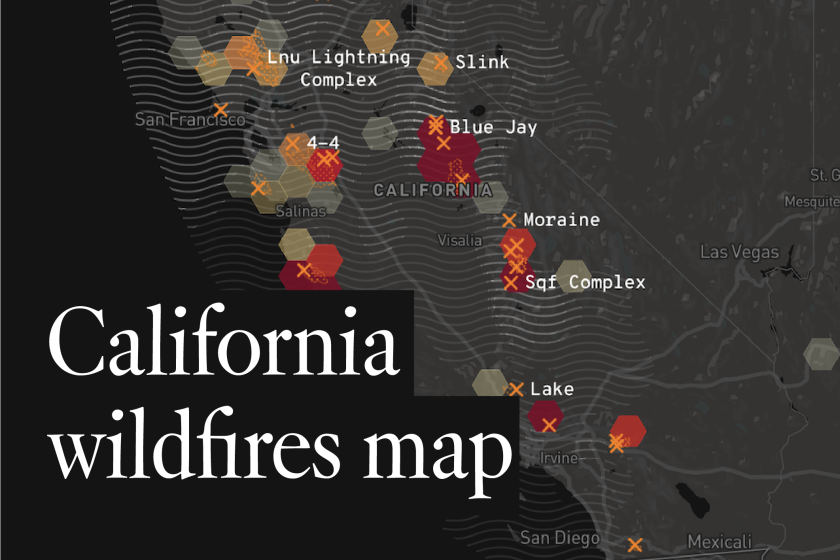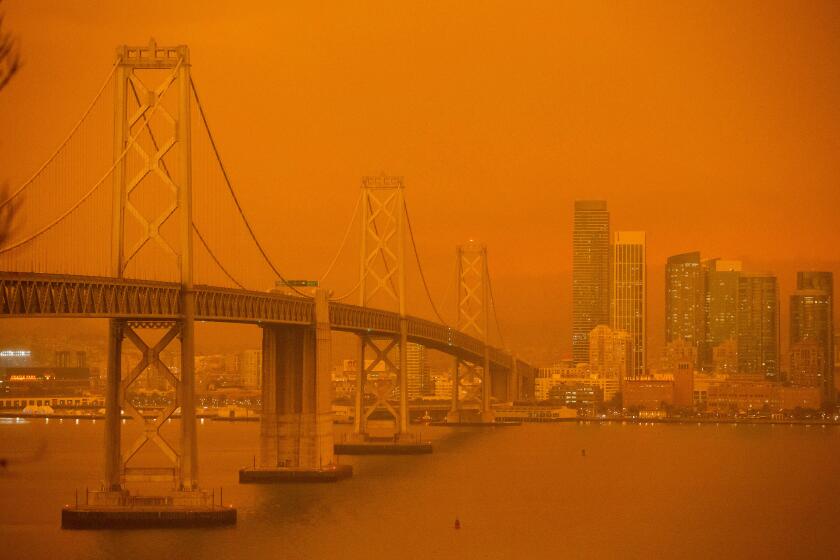How climate change is fueling record-breaking California wildfires, heat and smog
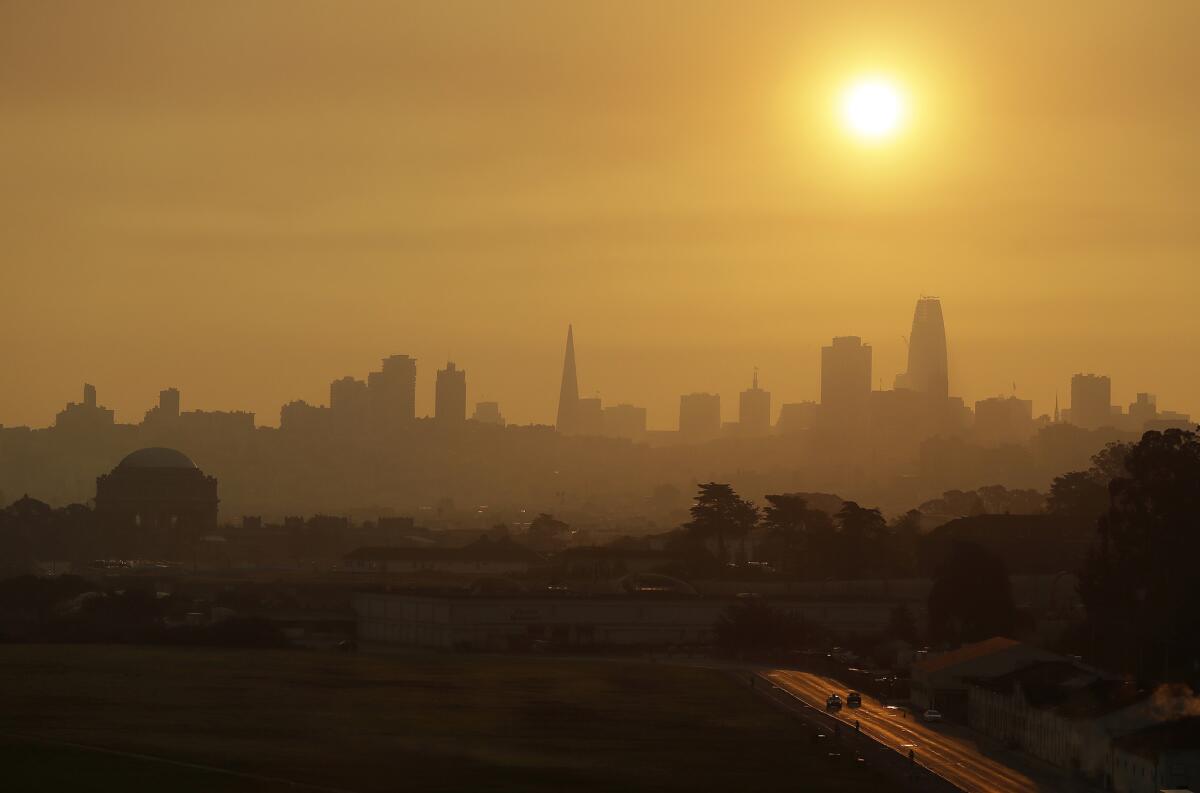
- Share via
In 2001, a team of international scientists projected that during the next 100 years, the planet’s inhabitants would witness higher maximum temperatures, more hot days and heat waves, an increase in the risk of forest fires and “substantially degraded air quality” in large metropolitan areas as a result of climate change.
In just the past month, nearly two decades after the third United Nations Intergovernmental Panel on Climate Change report was issued, heat records were busted across California, more than 3 million acres of land burned, and in major metropolitan areas, such as Los Angeles and San Francisco, air pollution has skyrocketed.
“This shouldn’t come as a surprise to anyone,” said Michael Gerrard, director of the Sabin Center for Climate Change Law at Columbia University. “Maybe we underestimated the magnitude and speed” at which these events would occur, he said, but “we’ve seen this long freight train barreling down on us for decades, and now the locomotive is on top of us, with no caboose in sight.”
In a matter of weeks, California has experienced six of the 20 largest wildfires in modern history and toppled all-time temperature records from the desert to the coast. Millions are suffering from some of the worst air quality in years due to heat-triggered smog and fire smoke. A sooty plume has blanketed most of the West Coast, blotting out the sun and threatening people’s lungs during a deadly pandemic.
California is being pushed to extremes. And the record heat, fires and pollution all have one thing in common: They were made worse by climate change. Their convergence is perhaps the strongest signal yet that the calamity climate scientists have warned of for years isn’t far off in the future; it is here today and can no longer be ignored.
“What we’ve been seeing in California are some of the clearest events where we can say this is climate change — that climate change has clearly made this worse,” said Zeke Hausfather, a climate scientist at the Breakthrough Institute, an Oakland-based think tank. “People who have lived in California for 30, 40 years are saying this is unprecedented, it has never been this hot, it has never been this smoky in all the years I’ve lived here.”
Air quality officials said the high pollution readings were a result of intense heat combined with stagnant weather conditions.
Unprecedented, yes. But not unexpected.
Since the 1980s, government and oil industry scientists have been anticipating the events that have transpired across the state this past month.
As one 1988 internal Shell Oil Co. document noted, “by the time the global warming becomes detectable it could be too late to take effective countermeasures to reduce the effects or even to stabilize the situation.”
“I’m only sorry that in 1989, I could not get an audience for what I wanted to communicate,” said Jim Hansen, a retired NASA researcher and early climate change scientist, of testimony he made to Congress about the issue.
Record temperatures
Each of the extremes Californians are living through right now is fueled, at least in part, by the gradual warming of the planet, which is accelerating as greenhouse gas emissions continue to rise.
California summers are 2.5 degrees warmer than they were in the 1970s and are on track to heat up an additional 4.5 degrees by the end of the century if the world’s current emissions trajectory continues, said Hausfather.
While precise attribution studies on the extreme heat waves in California in recent weeks will take time to complete, he said, they are clear examples of how climate change compounds natural weather variability to increase the likelihood of what once would have been a rare event.
“In a world without climate change, it still would have been a hot August; we still would have had some fires. But it’s clear that climate change has made things notably worse,” he said. “An extreme heat event that would have been 100 degrees is now 102.5 or 103 degrees, and that is actually a pretty big difference in terms of the impacts on people.”
During the mid-August heat wave, Death Valley soared to 130 degrees, one of the hottest temperatures ever recorded on Earth.
Another ferocious heat wave over the Labor Day weekend brought Death Valley-like heat to other areas. Los Angeles County had its hottest temperature on record when Woodland Hills hit 121 degrees Sept. 6. At Cal Poly San Luis Obispo, it reached 120 degrees, the highest reading since record-keeping began in 1869, in an area that is less than 10 miles from the Pacific Ocean.
The outlook for September is similarly harsh, with at least a 50% chance of higher-than-normal temperatures, according to national agency.
John Lindsey, a marine meteorologist with Pacific Gas and Electric, said the mercury rose to unprecedented levels in San Luis Obispo due to hot, downslope winds blowing from the northeast. They are known locally as Santa Lucia winds and can increase temperatures by 5.5 degrees for every 1,000 feet they descend.
“It was just rip-roaring hot,” said Lindsey, who has forecast weather along the Central Coast since 1991. “You just don’t expect Death Valley temperatures along coastal California.”
Lindsey, who acknowledges that he was a bit of a climate skeptic in the past, said seeing the increase in seawater temperatures, in particular, over many years “was a real epiphany or wake-up call.”
“By now, there’s no doubt in most people’s minds that the atmosphere is warming and the ocean is warming,” he said. “With the way greenhouse gases are increasing, in my mind, there’s no doubt that we’re causing this. It’s human activity that’s causing this. So I’m concerned about the future. And that’s somebody who’s very skeptical.”
Global warming has increased the odds of unprecedented heat extremes across more than 80% of the planet and “has doubled or even, in some areas, tripled the odds of record-setting hot events” in California and the Western U.S., said Stanford University climate scientist Noah Diffenbaugh.
An unprecedented firestorm
When it comes to wildfires, “what we’ve had in California over the last three to four weeks is unprecedented in our historical experience,” Diffenbaugh said.
“This is more extreme than any other year in living memory,” he said, and is consistent with the impact of global warming.
Research by Diffenbaugh and colleagues that was published last month found that the number of days with extreme wildfire weather in California has more than doubled since the early 1980s, primarily due to warming temperatures drying out vegetation.
“It means that even with no change in the frequency of strong wind events, even with no change in the frequency of lightning, the risk of wildfire and risk of large, rapidly growing wildfires goes up as a result of the effect of that warming,” he said.
And it’s that atmospheric warming that has set the stage for the fires raging throughout the western U.S., said Park Williams, a hydroclimatologist at Columbia University’s Lamont-Doherty Earth Observatory.
“If we think of the atmosphere as a giant sponge that’s always trying to extract water from the landscape, then temperature increases the sponginess,” he said.
As soils become drier, heat waves become more intense. That’s because the energy in the atmosphere is no longer being used in evaporation but is just building up heat. And as heat increases and soils — and, therefore, fuel for fires — dry out, the risk grows, laying the foundation for the type of wild and destructive fires we are now observing.
“That’s why, I think, you keep reading quotes from these firefighters who say they are seeing fire behavior unlike anything they’ve seen before,” he said. “As we go out in the future, in a world with this exponentially growing risk … we’re going to see fires far different than we’ve seen before.”
He noted that fires are not unusual in California — they are an integral part of the state’s history and landscape. Bad forest management, combined with human behavior — intentional and unintentional starting of fires — have contributed to the problem. But the effect of climate change is real and growing.
“We have seen the rapid warming of California summers really turbocharge the type of conditions that are suitable for rapid growth of wildfires,” Hausfather said. “We see fires growing from essentially nothing to a quarter of a million acres in one day. And that’s because the conditions are ripe, and temperature plays a large role.”
John Abatzoglou, associate professor in the Department of Management of Complex Systems at UC Merced, agreed.
“What we are seeing play out does indeed have human fingerprints on it, including those from climate change,” he said.
“We can see how warm and dry years catalyze these fires,” he said, adding, however, that for fires to start, “they need to have ignitions. But the heat and dryness have absolutely set the table for widespread fire activity.”Dreadful air quality
It was no coincidence that ozone pollution levels in downtown Los Angeles spiked to their highest levels since the mid-1990s on a day in which temperatures reached an all-time high for the county, said Cesunica Ivey, an assistant professor of chemical and environmental engineering at UC Riverside who studies air quality.
The global rise in temperatures observed over decades is also occurring locally, she said, “and these frequently occurring heat waves, this upward trend in basin-wide average temperature, is contributing to ozone exacerbation.”
With so many fires burning, millions of people in the Bay Area, Central Valley and parts of Southern California are breathing dangerous levels of particle pollution.
Southern California regulators have seen decades of progress fighting smog stymied in recent years by hotter weather and stronger, more persistent inversion layers that trap pollution near the ground. Their efforts are being hindered by rising temperatures from climate change, according to air quality experts.
That’s because hotter weather speeds up the photochemical reactions that turn pollutants from vehicle tailpipes and other sources into ozone, the invisible, lung-damaging gas in summer smog. Studies show that ozone levels are about two parts per billion higher than they would be without global warming.
What precisely is driving changes such as elevated smog levels can be hard to tease out in the middle of an extreme event because so much is happening at once, with multiple hazards piling on top of each other in a vicious feedback loop.
The recent heat spells, for instance, both fueled smog formation and led to power outages. Gov. Gavin Newsom suspended air quality rules on power plants and other polluters to ease strain on the grid, allowing more emissions to sully the air. The COVID-19 pandemic has added an additional layer of complexity at a time when Californians are trying to protect their homes, lungs and bodies from threats that seem to be coming from all sides.
“When you add COVID, extreme heat, wildfires and air pollution all together, they’re all detrimental to public health, and it just makes things worse,” said Yifang Zhu, a professor of environmental health sciences at UCLA Fielding School of Public Health who studies air pollution and its effects. “These stressors are happening at the same time. So the impact is cumulative and maybe even synergistic to each other.”
That cascading effect, in which one extreme compounds another, is a feature of global warming that experts have long warned about.
Ivey, of UC Riverside, said she and other scientists aren’t surprised to see so many extremes hitting simultaneously, “but to see it playing out is scary.”
“It’s one of those moments where ozone converged with record acres burned and a heat wave,” she said. “If the writing isn’t on the wall, then I don’t know what to tell folks.”
Global warming is also fueling increases in wildfire pollution, a mix of soot particles and gases that can fuel ozone formation and dramatically worsen smog. Those added emissions are only going to get worse as the severity and frequency of fires increases.
“People may not directly connect local air pollution to global climate change, but they are intertwined,” said Zhu. “They are two sides of the same coin.”
What this year’s extreme heat, fire and air quality degradation is showing, said Columbia’s Williams, is that we are, in a sense, blindly stepping off a cliff from a world in which we could somewhat predict what was going to happen, based on decades and centuries of data.
“We’re finding that we’ve lost complete control,” he said. “The baselines we’ve used for decades no longer apply. There really isn’t a normal anymore.”
More to Read
Sign up for Essential California
The most important California stories and recommendations in your inbox every morning.
You may occasionally receive promotional content from the Los Angeles Times.
